Low Cycle Fatigue Behavior of Plastically Pre-Strained HSLA S355MC and S460MC Steels
Abstract
1. Introduction
2. Materials and Experimental Procedure
3. Results and Discussion
3.1. Microstructural Features
3.2. Tensile Properties
3.3. Strain–Life Diagrams
3.4. Cyclic Behavior
3.5. Fractographic Observations
4. Conclusions
- In unstrained conditions, the S460MC material has higher yield and tensile strength but lower elongation compared to the S355MC material. With increasing plastic pre-strain, yield strength in both materials increases and elongation decreases considerably. Cyclic yield strength increases after pre-straining in both materials, while the cyclic strain hardening exponent increases in S460MC and decreases in S355MC steel with the increase in pre-strain level.
- The transition life from low to high cycle fatigue decreases with increasing plastic pre-straining in both S355MC and S460MC materials.
- LCF performance is influenced (apart from ductility) by the cyclic behavior of materials. Plastic pre-straining induces cyclic softening in both steels and, in the S460MC material, LCF performance in the presence of cyclic softening is degraded compared to the unstrained material. The transition from cyclic softening to hardening at large strain amplitudes in the reference S355MC material negatively impacts its LCF performance with regard to the pre-strained conditions.
- SEM fractography revealed that pre-straining in both materials results in a reduction in the fatigue section with regard to the unstrained material condition. The S355MC steel showed smaller fatigue striation spacing in the pre-strained compared to the unstrained condition, indicative of a lower crack growth rate, which explains the deterioration in fatigue life of the unstrained compared to pre-strained S355MC steel. In the case of S460MC steel, the differences in striation spacing between unstrained and pre-strained material were small.
Author Contributions
Funding
Data Availability Statement
Acknowledgments
Conflicts of Interest
Nomenclature
| b | cyclic stress exponent |
| c | cyclic ductility exponent |
| E | modulus of elasticity |
| K′ | cyclic hardening coefficient |
| n′ | cyclic hardening exponent |
| Nf | cycles to failure |
| εa,el | elastic strain amplitude |
| εa,pl | plastic strain amplitude |
| εa,t | total strain amplitude |
| cyclic ductility coefficient | |
| σα | stress amplitude |
| cyclic stress coefficient |
References
- Dieter, G.E. Mechanical Metallurgy, 3rd ed.; McGraw-Hill: New York, NY, USA, 1988. [Google Scholar]
- Bagherpour, E.; Pardis, N.; Reihanian, M.; Ebrahimi, R. An overview on severe plastic deformation: Research status, techniques classification, microstructure evolution, and applications. Int. J. Adv. Manuf. Technol. 2019, 100, 1647–1694. [Google Scholar] [CrossRef]
- Abambres, M.; Quach, W.M. Residual stresses in steel members: A review of available analytical expressions. Int. J. Struct. Integr. 2016, 7, 70–94. [Google Scholar] [CrossRef]
- James, M.N. Residual stress influences on structural reliability. Eng. Fail. Anal. 2011, 18, 1909–1920. [Google Scholar] [CrossRef]
- Misiūnaitė, I.; Rimkus, A.; Jakuboskis, R.; Sokolov, A.; Gribniak, V. Analysis of local deformation effects in cold-formed tubular profiles subjected to bending. J. Constr. Steel Res. 2019, 160, 598–612. [Google Scholar] [CrossRef]
- Chen, J.; Liu, H.; Chan, T.M. Material properties and residual stresses of cold formed octagonal hollow sections. J. Constr. Steel Res. 2020, 170, 106078. [Google Scholar] [CrossRef]
- Huynh, L.A.T.; Pham, C.H.; Rasmussen, K.J.R. Mechanical properties and residual stresses in cold-rolled aluminum channel sections. Eng. Struct. 2019, 199, 109562. [Google Scholar] [CrossRef]
- Kusakin, P.; Belyakov, A.; Haase, C.; Kaibyshev, R.; Molodov, D.A. Microstructure evolution and strengthening mechanisms of Fe-23Mn-0.3C-1.5Al TWIP steel during cold rolling. Mater. Sci. Eng. A 2014, 617, 52–60. [Google Scholar] [CrossRef]
- Li, B.L.; Godfrey, A.; Meng, Q.C.; Liu, Q.; Hansen, N. Microstructural evolution of IF-steel during cold rolling. Acta Mater. 2004, 52, 1069–1081. [Google Scholar] [CrossRef]
- McDowell, D.L. Multiscale Modeling of Interfaces, Dislocations, and Dislocation Field Plasticity: Courses and Lectures. In Mesoscale Models; Springer International Publishing: Berlin/Heidelberg, Germany, 2019; pp. 195–297. [Google Scholar]
- He, B.B.; Hu, B.; Yen, H.W.; Cheng, G.J.; Wang, Z.K.; Luo, H.W.; Huang, M.X. High dislocation density-induced large ductility in deformed and partitioned steels. Science 2017, 357, 1029–1032. [Google Scholar] [CrossRef]
- Quach, W.M.; Qiu, P. Strength and ductility of corner materials in cold-formed stainless steel sections. Thin-Walled Struct. 2014, 83, 28–42. [Google Scholar] [CrossRef]
- Yan, B.; Belanger, P.; Citrin, K. Effect of Forming Strain on Fatigue Performance of a Mild Automotive Steel. In SAE Transactions; (SAE Technical Paper Series); SAE International: Warrendale, PA, USA, 2001. [Google Scholar]
- Pereira, J.C.R.; de Jesus, A.M.P.; Fernandes, A.A.; Varelis, G. Monotonic, low-cycle fatigue and ultra-low cycle fatigue behaviours of the X52, X60 and X65 piping steels grades. J. Press. Vessel. Technol. 2016, 138, 031403. [Google Scholar] [CrossRef]
- Das, B.; Singh, A.; Paul, S.K. Low cycle fatigue performance of DP600 steel under various pre-straining paths. Int. J. Fatigue 2020, 132, 105331. [Google Scholar] [CrossRef]
- Sherman, A.M.; Davies, R.G. Fatigue of a Dual-Phase Steel. Metall. Trans. A 1979, 10, 929–933. [Google Scholar] [CrossRef]
- Sherman, A.M. Fatigue Properties of High Strength-Low Alloy Steels. Metall. Trans. A 1975, 6, 1035–1040. [Google Scholar] [CrossRef]
- Aichbhaumik, D. Steel Variability Effects on Low Cycle Fatigue Behavior of a Single Grade of High Strength Low Alloy Steel. Metall. Trans. A 1979, 10, 269–278. [Google Scholar] [CrossRef]
- Raman, S.G.S.; Padmanabhan, K.A. Effect of Prior Cold Work on the Room Temperature Low-Cycle Fatigue Behaviour of AISI 304LN Stainless Steel. Int. J. Fatigue 1996, 18, 71–79. [Google Scholar] [CrossRef]
- Ghosal, P.; Raj, A.; Paul, S.K. Influence of uniaxial and biaxial pre-straining on the low cycle fatigue performance of DP590 steel. Int. J. Fatigue 2021, 149, 106260. [Google Scholar] [CrossRef]
- Jin, X.; Ji, S.; Liu, C.; Shi, S.; Chen, X. Comparison of low cycle fatigue behavior of 304 stainless steels induced by tensile and torsional prestrain. Fatigue Fract. Eng. Mater. Struct. 2020, 43, 2247–2258. [Google Scholar] [CrossRef]
- Chang, L.; Ma, T.-H.; Wen, J.-B.; Zhou, B.-B.; Li, J.; He, X.-H.; Zhou, C.-Y. The distinct influences of pre-strain on low cycle fatigue behavior of CP-Ti along rolling direction at different strain amplitudes. Mater. Sci. Eng. A 2019, 763, 138150. [Google Scholar] [CrossRef]
- Singh, J.; Wheatley, G.; Branco, R.; Antunes, F.V.; Nejad, R.M.; Berto, F. On the low-cycle fatigue behavior of aluminum alloys under influence of tensile pre-strain histories and strain ratio. Int. J. Fatigue 2022, 158, 106747. [Google Scholar] [CrossRef]
- Branco, R.; Costa, J.D.; Borrego, L.P.; Wu, S.C.; Long, X.Y.; Antunes, F.V. Effect of tensile pre-strain on low-cycle fatigue behaviour of 7050-T6 aluminium alloy. Eng. Fail. Anal. 2020, 114, 104592. [Google Scholar] [CrossRef]
- Prosgolitis, C.G.; Kermanidis, A.T.; Kamoutsi, H.; Haidemenopoulos, G.N.; Karamanos, S.A. Influence of plastic prestraining on the fatigue crack propagation rate of S355MC and S460MC structural steels. Fatigue Fract. Eng. Mater. Struct. 2021, 44, 1391–1405. [Google Scholar] [CrossRef]
- SEP 1240. Testing and Documentation Guideline for the Experimental Determination of Mechanical Properties of Steel Sheets for CAE Calculations, 1st ed.; Institute VDEh, Verlag Stahleisen GmbH: Dusseldorf, Germany, 2006. [Google Scholar]
- Manson, S.S. Fatigue: A Complex Subject—Some Simple Approximations. Exp. Mech. 1965, 5, 193–226. [Google Scholar] [CrossRef]
- Ramberg, W.; Osgood, W.R. Description of Stress–Strain Curves by Three Parameters; Technical Note No. 902; National Advisory Committee for Aeronautics: Washigton, DC, USA, 1943. [Google Scholar]
- Ślęzak, T.; Śnieżek, L. A Comparative LCF Study of S960QL High Strength Steel and S355J2 Mild Steel. Procedia Eng. 2015, 114, 78–85. [Google Scholar] [CrossRef]
- Macek, W.; Robak, G.; Zak, K.; Branco, R. Fracture surface topography investigation and fatigue life assessment of notched austenitic steel specimens. Eng. Fail. Anal. 2022, 135, 106121. [Google Scholar] [CrossRef]
- Cai, H.; McEvily, A.J. On striations and fatigue crack growth in 1018 steel. Mater. Sci. Eng. A 2001, 314, 86–89. [Google Scholar] [CrossRef]
- Christodoulou, P.I.; Kermanidis, A.T.; Krizan, D. Fatigue behavior and retained austenite transformation of Al-containing TRIP steels. Int. J. Fatigue 2016, 91, 220–231. [Google Scholar] [CrossRef]
- Hutchinson, B. Deformation microstructures and textures in steels. Philos. Trans. R. Soc. Lond. 1999, 357, 1471–1485. [Google Scholar] [CrossRef]
- Suwas, S.; Mondal, S. Texture Evolution in Severe Plastic Deformation Processes. Mater. Trans. 2019, 60, 1457–1471. [Google Scholar] [CrossRef]
- Villechaise, P.; Mineur, M.; Mendez, J. Analysis of texture effects on fatigue behaviour of 316L stainless steel. J. Phys. IV 2001, 11, 311–319. [Google Scholar] [CrossRef]
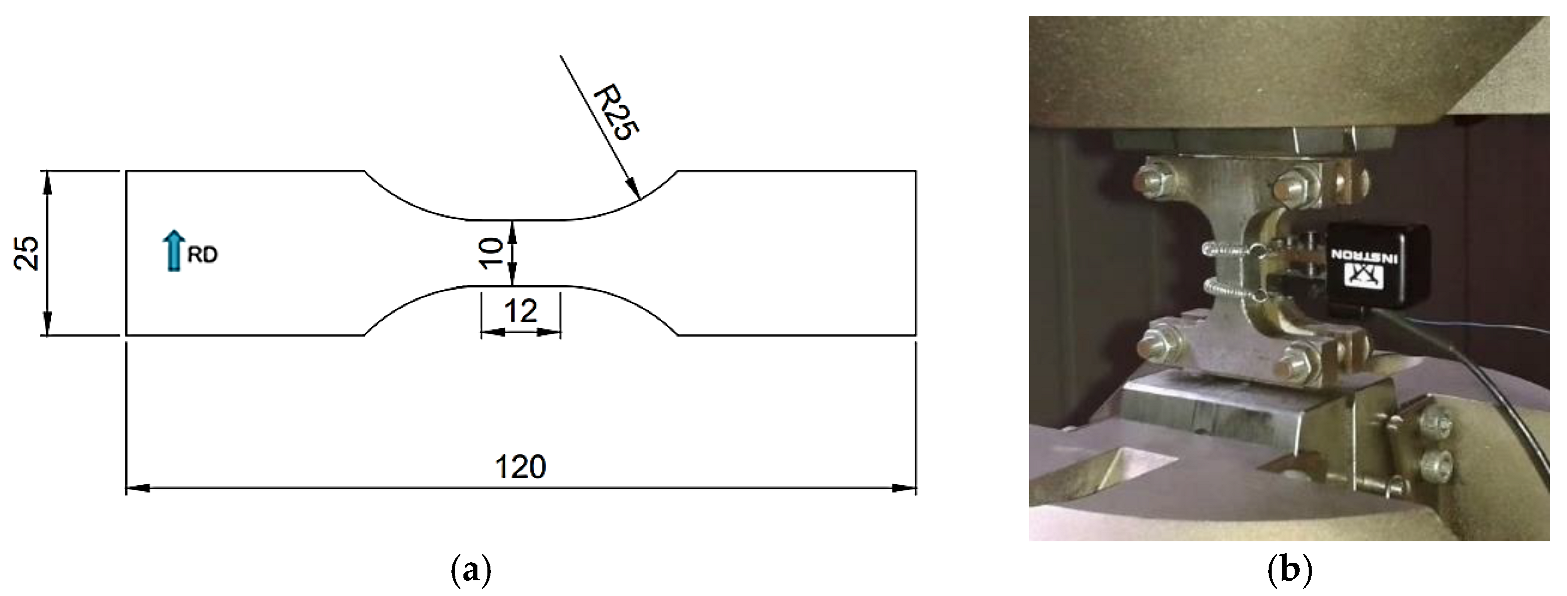
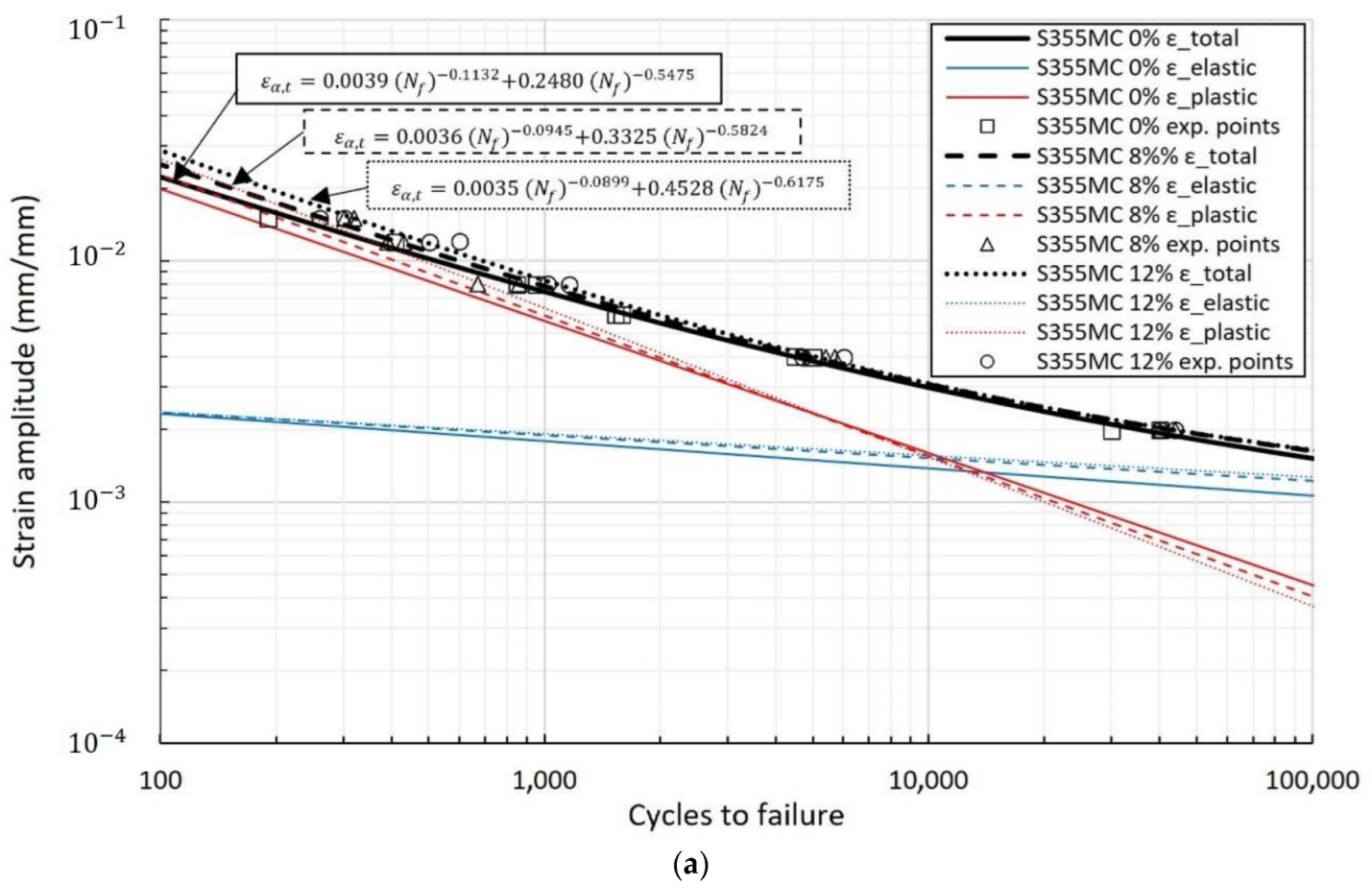
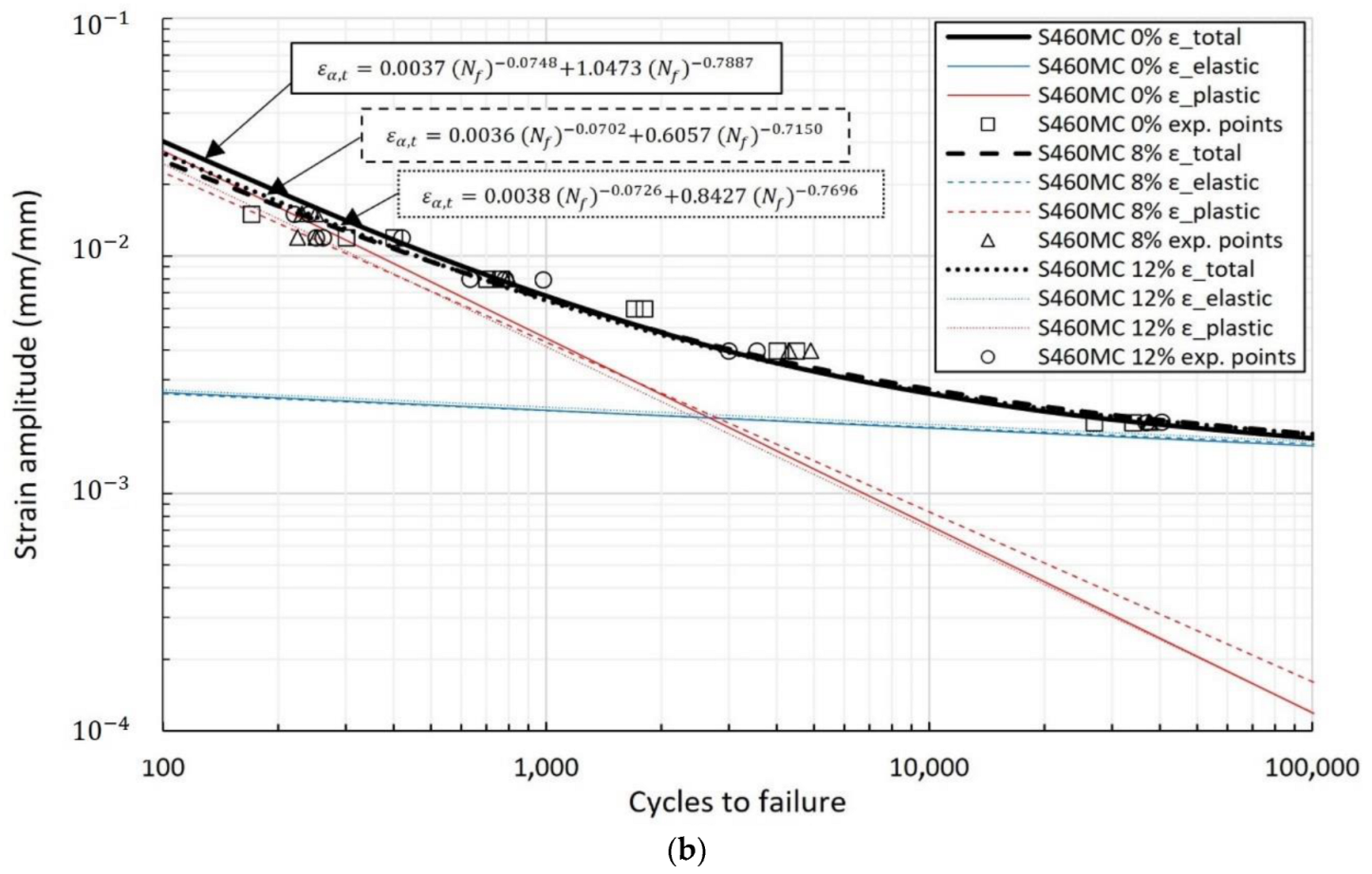
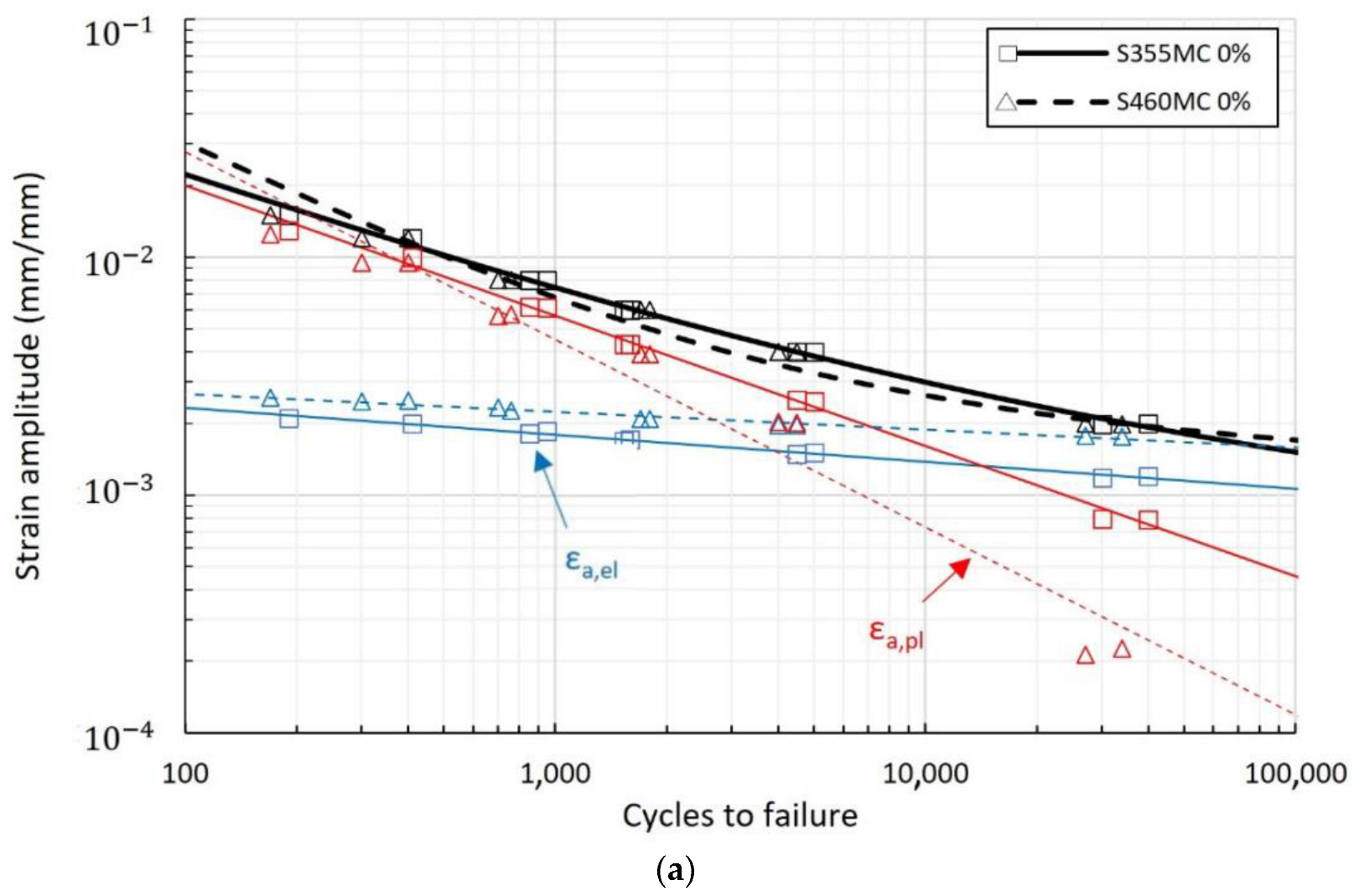
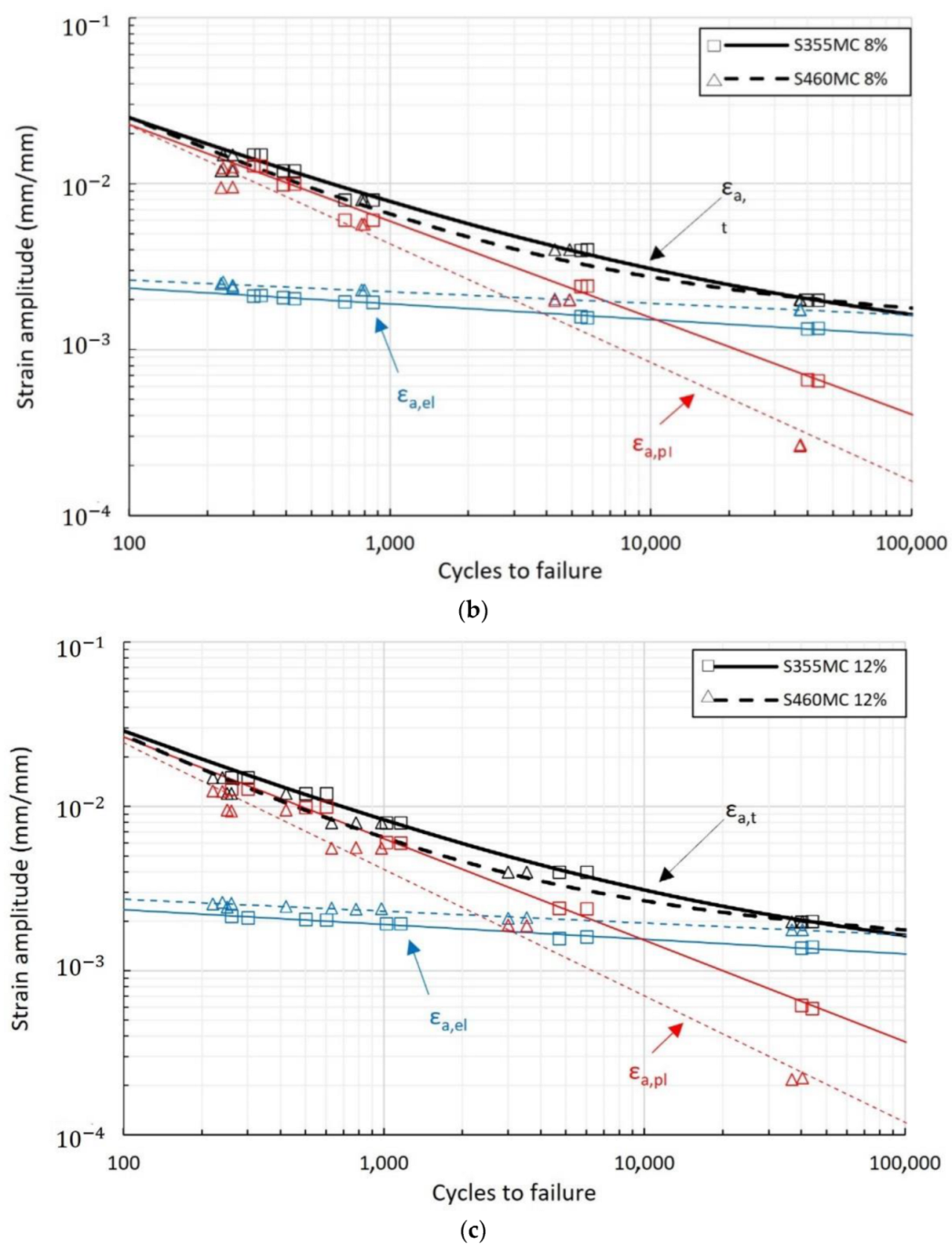
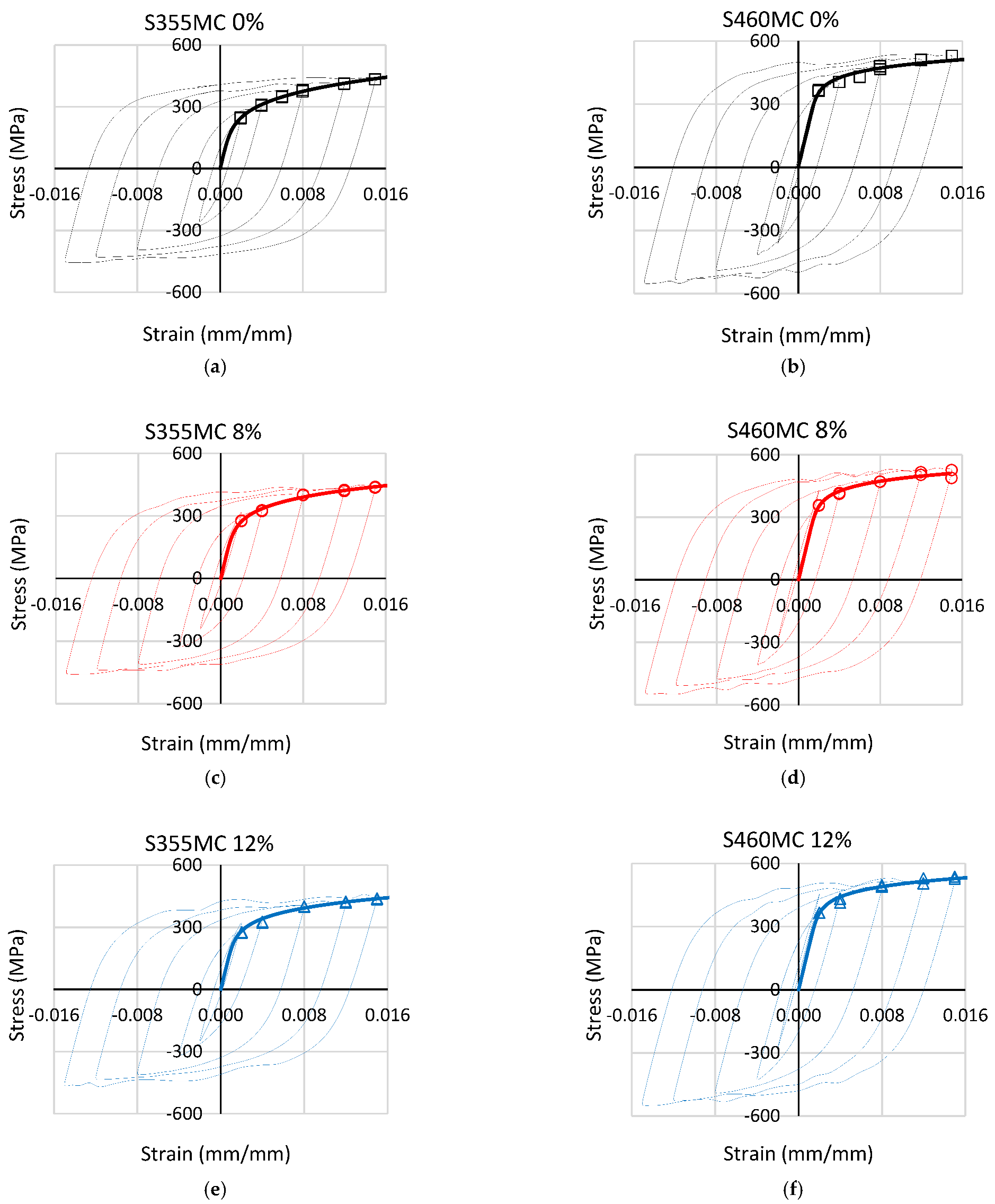
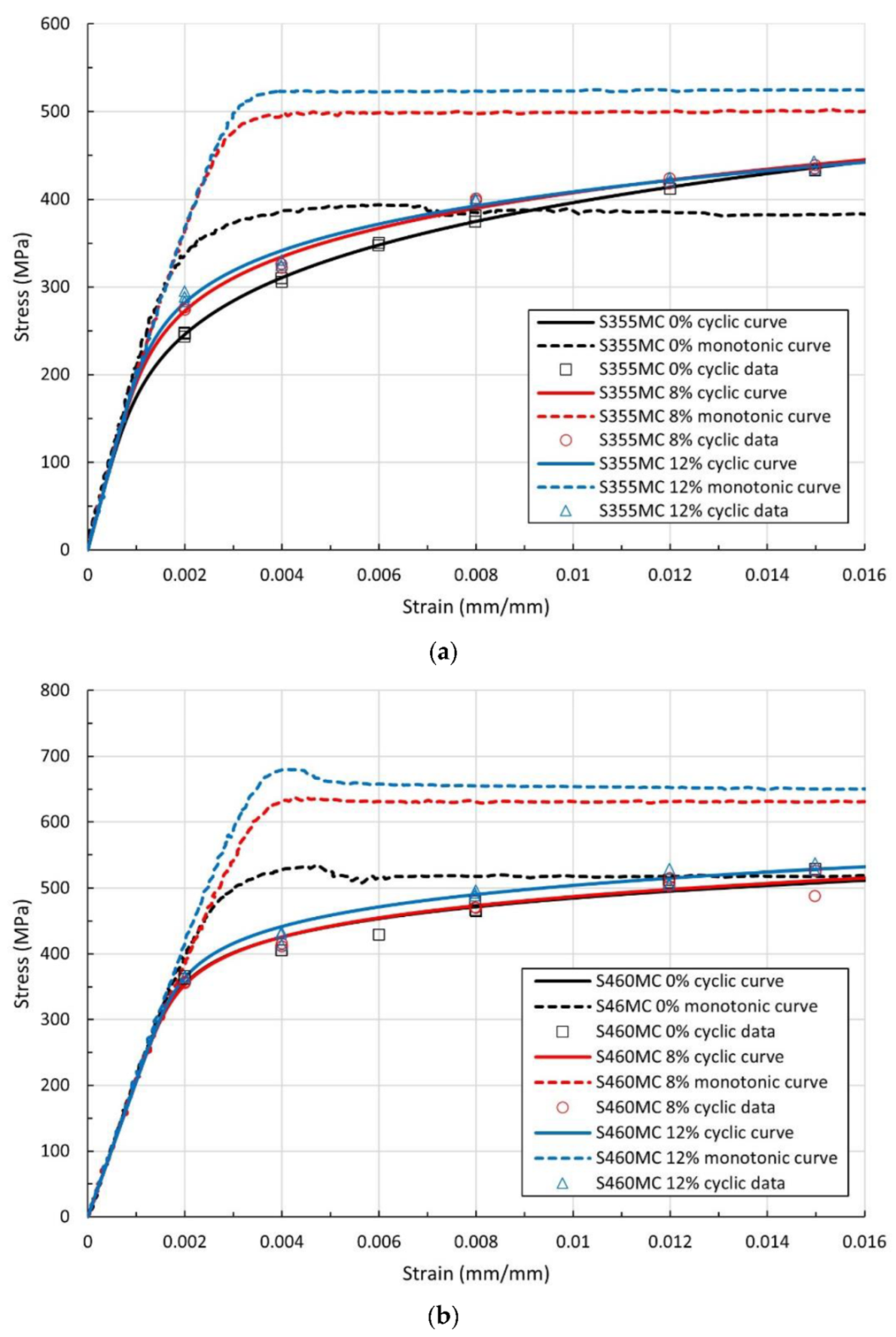
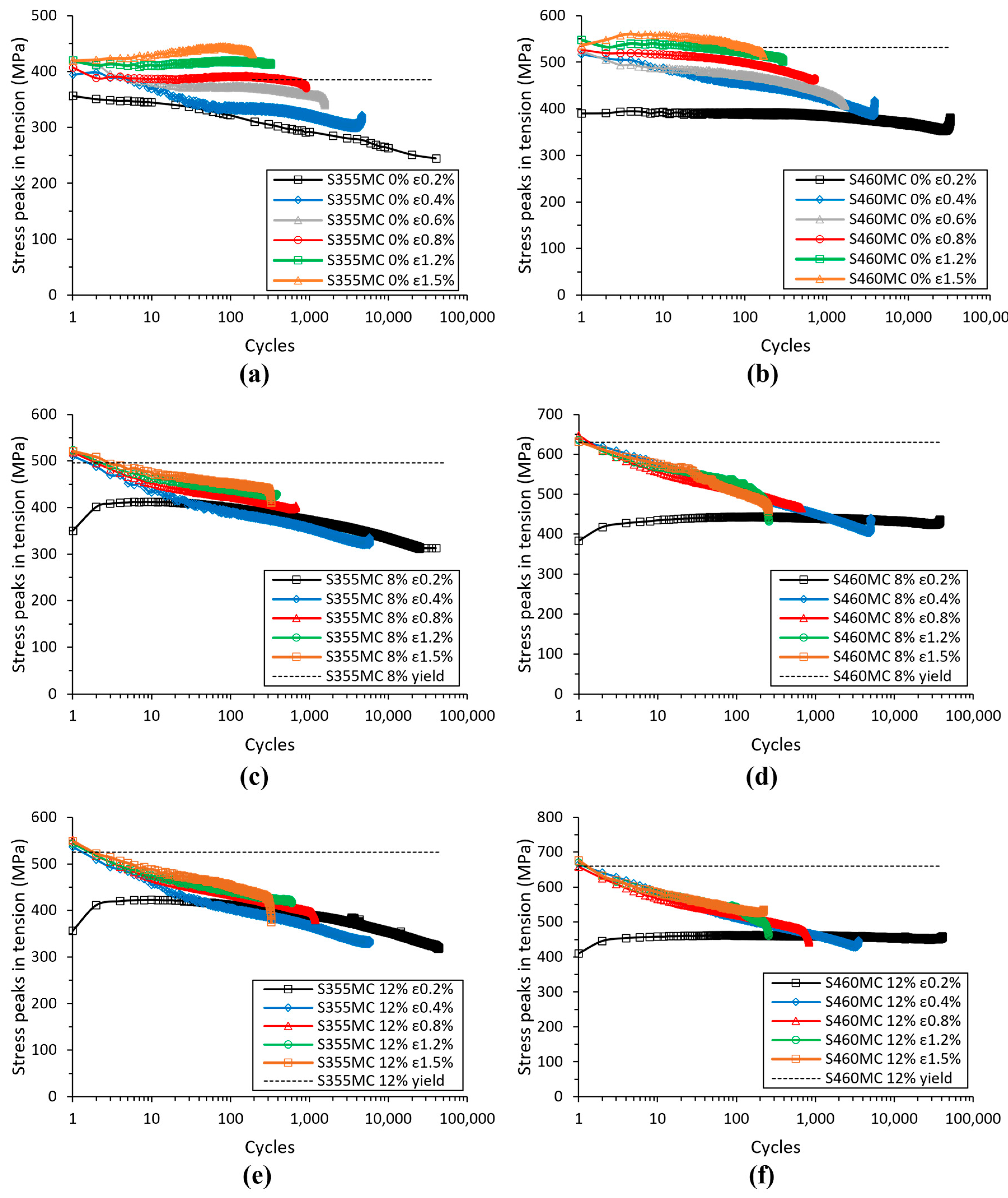
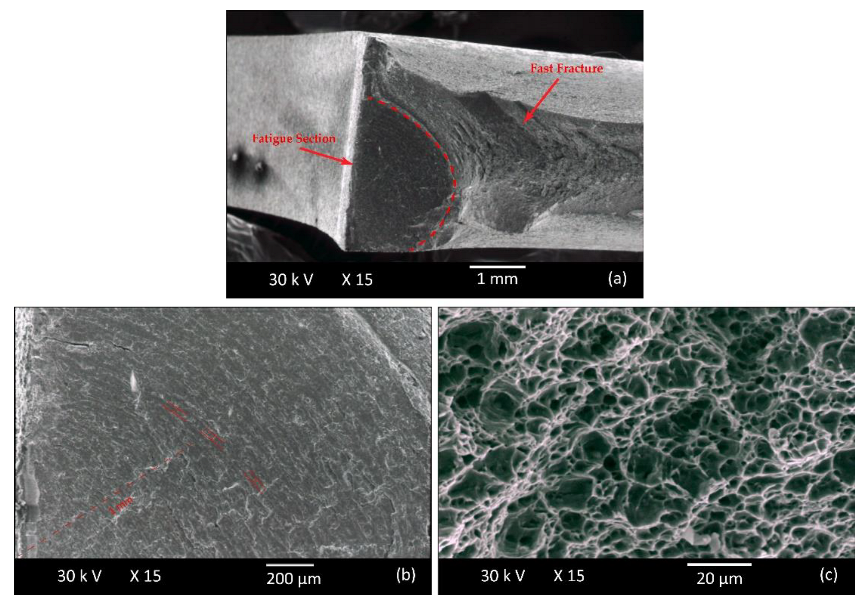
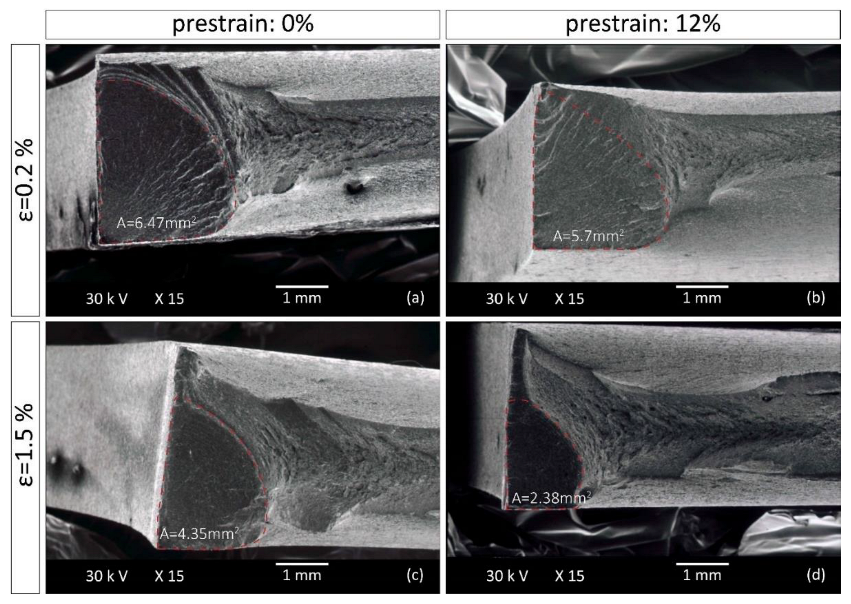

| C | Si | Mn | P | S, Ti, V | Mo | Nb | Cu | Ni | Cr | N | Al | |
|---|---|---|---|---|---|---|---|---|---|---|---|---|
| S355MC | 0.07 | <0.01 | 0.57 | 0.01 | <0.01 | 0.01 | 0.02 | 0.01 | 0.04 | 0.03 | 0.003 | 0.03 |
| S460MC | 0.06 | 0.20 | 0.83 | 0.03 | <0.01 | 0.01 | 0.06 | 0.01 | 0.02 | 0.04 | 0.009 | 0.03 |
| Material | Pre-Strain Level (%) | Strain Amplitude |
|---|---|---|
| S355MC | 0, 8, 12 | 0.002 |
| 0.004 | ||
| 0.006 | ||
| 0.008 | ||
| 0.012 | ||
| 0.015 | ||
| S460MC | 0, 8, 12 | 0.002 |
| 0.004 | ||
| 0.006 | ||
| 0.008 | ||
| 0.012 | ||
| 0.015 |
| Material | Plastic Pre-Strain Level (%) | Yield Strength σy (MPa) | Tensile Strength σUTS (MPa) | Elongation at Fracture (%) |
|---|---|---|---|---|
| S355MC | 0 | 380 | 470 | 41 |
| 8 | 480 | 512 | 23 | |
| 12 | 510 | 527 | 20 | |
| S460MC | 0 | 490 | 590 | 27 |
| 8 | 610 | 630 | 16 | |
| 12 | 635 | 653 | 11 |
| Material | Pre-Strain Level | b | c | ||
|---|---|---|---|---|---|
| S355MC | 0% | 804.94 | −0.1132 | 0.2480 | −0.5475 |
| 8% | 746.29 | −0.0945 | 0.3325 | −0.5824 | |
| 12% | 735.42 | −0.0899 | 0.4528 | −0.6175 | |
| S460MC | 0% | 773.06 | −0.0748 | 1.0473 | −0.7887 |
| 8% | 748.19 | −0.0702 | 0.6057 | −0.7150 | |
| 12% | 782.59 | −0.0726 | 0.8427 | −0.7696 |
| Material | Pre-Strain Level | n′ | K′ (MPa) | σyc (MPa) |
|---|---|---|---|---|
| S355MC | 0% | 0.2051 | 1064.60 | 300 |
| 8% | 0.1608 | 885.18 | 330 | |
| 12% | 0.1381 | 795.52 | 340 | |
| S460MC | 0% | 0.0883 | 740.04 | 425 |
| 8% | 0.0960 | 775.90 | 435 | |
| 12% | 0.0955 | 799.71 | 450 |
| Material | Pre-Strain Level | Striation Spacing (μm) |
|---|---|---|
| S355MC | 0% | 23 ± 2 |
| 12% | 11 ± 2 | |
| S460MC | 0% | 18 ± 1 |
| 12% | 15 ± 1 |
Publisher’s Note: MDPI stays neutral with regard to jurisdictional claims in published maps and institutional affiliations. |
© 2022 by the authors. Licensee MDPI, Basel, Switzerland. This article is an open access article distributed under the terms and conditions of the Creative Commons Attribution (CC BY) license (https://creativecommons.org/licenses/by/4.0/).
Share and Cite
Prosgolitis, C.G.; Kermanidis, A.T.; Kamoutsi, H.; Haidemenopoulos, G.N. Low Cycle Fatigue Behavior of Plastically Pre-Strained HSLA S355MC and S460MC Steels. Materials 2022, 15, 7927. https://doi.org/10.3390/ma15227927
Prosgolitis CG, Kermanidis AT, Kamoutsi H, Haidemenopoulos GN. Low Cycle Fatigue Behavior of Plastically Pre-Strained HSLA S355MC and S460MC Steels. Materials. 2022; 15(22):7927. https://doi.org/10.3390/ma15227927
Chicago/Turabian StyleProsgolitis, Christos G., Alexis T. Kermanidis, Helen Kamoutsi, and Gregory N. Haidemenopoulos. 2022. "Low Cycle Fatigue Behavior of Plastically Pre-Strained HSLA S355MC and S460MC Steels" Materials 15, no. 22: 7927. https://doi.org/10.3390/ma15227927
APA StyleProsgolitis, C. G., Kermanidis, A. T., Kamoutsi, H., & Haidemenopoulos, G. N. (2022). Low Cycle Fatigue Behavior of Plastically Pre-Strained HSLA S355MC and S460MC Steels. Materials, 15(22), 7927. https://doi.org/10.3390/ma15227927







